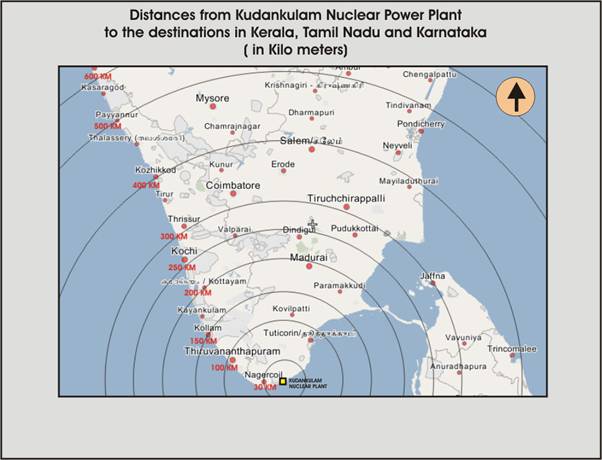By V.T.PADMANABHAN
Cesium is a radioactive element created when a uranium atom is fissioned in the nuclear reactor. About 100 trillion trillion (10^26) atoms of cesium were released and was deposited in almost all places in the Northern hemisphere from Chernobyl in Ukraine when a reactor melt down and exploded in 1986. That would mean about one trillion atoms for every square meter of land and sea. From there, cesium gives off its gamma radiation, some 400 disintegration in every second from every square meter of land till 2016. After that, there will be 200 disintegrations per second till 2046. Each one of those disintegrations has the potential to damage your health or the health of your unborn child. Estimate of cesium and other radioactive particles being released from Fukushima will be available in about a month.
| The element cesium has no role in the biosphere. However, since it mimics potassium, plants take it up and it is thus pushed up in the food chain. The other radionuclides that mimic bioactive active elements are strontium and plutonium, which are stored in the bone as they look like calcium. Nuclear fission generate some 600 isotopes, of which 14 carbon (an isotope of carbon with 8 neutrons), tritium (hydrogen isotope with two neutrons), five isotopes of iodine, cesium, strontium and plutonium are more important internal emitters. |
150 million people live in Karnataka, Kerala and Tamil Nadu in the peninsular India , 25 million more than that in Japan . It is the spices capital of the world. People cultivate cardamom, pepper, tea, coffee, ginger, turmeric, coconut, cashew and many more edible crops. Besides, our fishermen harvest exotic fishes high in nutrition and low in carbon footprint from the seas and the backwaters. These reach the food baskets of more than half the population of this planet.
A large portion of the land in this Spice Capital of the world will be severely contaminated if a Fukushima type event occurs in one of the eight 1000 MW(e) reactors being built/ planned in Kudankulam near Kanyakumari in Tamil Nadu. Besides ruining the lives of our farmers and fishermen, this will deprive billions of people of their spices.
Map of Kudankulam target area and approximate population living there are given below.

| LAND AND PEOPLE IN KUDANKULAM TARGET AREA | |||||
Distance | Total | Total | Range | Area in | Population |
from | Area | Population | km | Range | in the |
Source | Sq Km | in Area | Sq km | range | |
407 | |||||
500 | 392857 | 159892857 | 400-500 | 141429 | 57561429 |
400 | 251429 | 102331429 | 300-400 | 110000 | 44770000 |
300 | 141429 | 57561429 | 250-300 | 43214 | 17588214 |
250 | 98214 | 39973214 | 200-250 | 35357 | 14390357 |
200 | 62857 | 25582857 | 150-200 | 27500 | 11192500 |
150 | 35357 | 14390357 | 100-150 | 19643 | 7994643 |
100 | 15714 | 6395714 | 50-100 | 11786 | 4796786 |
50 | 3929 | 1598929 | 40-50 | 1414 | 575614 |
40 | 2514 | 1023314 | 30-40 | 1100 | 447700 |
30 | 1414 | 575614 | 20-30 | 786 | 319786 |
20 | 629 | 255829 | 10-20 | 471 | 191871 |
10 | 157 | 63957 | 5 -10 | 118 | 47968 |
5 | 39 | 15989 | 0 -5 | 39 | 15989 |
| Note: Average population density in three states in 2001 was 407. | |||||
| Since Kudankulam is a coastal site, the area is a semicircle. | |||||
| Since this is on the southern tip, the area and population will | |||||
| lesser than what is given above. This is only an approximation. | |||||
Courtesy: countercurrents.org
No comments:
Post a Comment